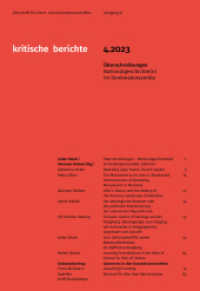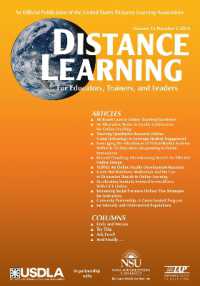基本説明
問診と身体診察のコツを抱括的に解読した好評書。4年ぶりの改訂版。
Chapters are filled with clinical pearls, vignettes, step-by-step methods, and explanations of the physiologic significance of findings. The previous ed.: 2005.
Full Description
The Fourth Edition of this textbook teaches the artful science of the patient interview and the physical examination-from the fundamentals to the most advanced levels. Written in an artful storytelling style, the book describes methods in step-by-step detail, with clinical pearls, vignettes, practical clinical experience, personal history, explanations of the physiologic significance of findings, and extensive discussions of evidence-based medicine.Highlights of this new edition include-"Points to Remember" boxes with three or four bullets per chapterMore than 300 questions with answers and discussionRevisions based on new material from journals (especially JAMA, New England Journal of Medicine, Mayo Clinic Proceedings, and Annals of Internal Medicine); CME conferences, especially the weekly grand rounds at Carondelet St. Joseph's Hospital; specialty conferences pertaining to orthopedics and neurology; and cases that recently came up in practiceMore than 120 additional references, some new and some old classics newly discovered by the authorExpanded discussion of evidence-based medicine, both its appropriate usage and pitfalls, with additional information on sensitivity, specificity, and other features of various findings from recent studies and review articles. Insights on the development of expertise have been added.Expanded discussion of sleep apnea, blast injury, "minor" head trauma, and cervical spine involvement in rheumatoid arthritisNew findings pertaining to transplantation-related graft-versus-host problems, AIDS and the adverse effects of therapy, drug abuse, especially methamphetamine, and egg donationAdditional maneuvers include the scapulohumeral reflex, the head thrust test, the apprehension test, and a newly described test for intercostal muscle innervationAdditional information on dementia, hysteria, missed aneurysms, pulmonary embolism, evaluation of dehydration/malnutrition, and compressions-only cardiopulmonary resuscitationUpdated and substantially simplified discussion of carotid stenosis and indications for carotid endarterectomyMore historical tidbits, for example, on the development of thermometryCompanion Website with fully searchable text and 300-question online test bankEven with all of today's sophisticated laboratory and imaging technology, a skillfully performed patient interview and physical examination can be a quicker and more cost-effective route to an accurate diagnosis. The Fourth Edition of Sapira's Art and Science of Bedside Diagnosis is your guide to gaining the most reliable information from your patients, developing a differential diagnosis and an efficient diagnostic strategy.
Contents
SECTION HEADINGS1: INTRODUCTION2: THE INTERVIEW3: THE HISTORY4: THE CASE RECORD5: GENERAL APPEARANCE6: THE VITAL SIGNS7: INTEGUMENT8: LYMPH NODES9: THE HEAD10: THE EYE11: THE EAR12: THE NOSE13: THE OROPHARYNX14: THE NECK15: THE BREAST16: THE CHEST17: THE HEART18: ARTERIES19: VEINS20: THE ABDOMEN21: MALE GENITALIA22: FEMALE GENITALIA23: THE RECTUM24: THE EXTREMITIES25: THE MUSCULOSKELETAL SYSTEM26: THE NEUROLOGIC EXAMINATION27: CLINICAL REASONING28: SOME BEDSIDE LABORATORY TRICKS29: ANNOTATED BIBLIOGRAPHY








